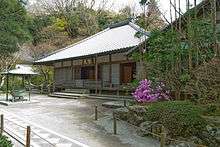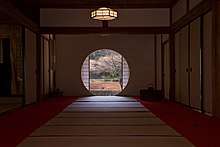Meigetsu-in
Fugenzan Meigetsu-in (福源山明月院) is a Rinzai Zen temple of the Kenchō-ji school in Kita-Kamakura, Kanagawa, Japan. Famous for its hydrangeas, it's also known as The Temple of Hydrangeas (ajisai-dera). The main object of worship is goddess Shō Kannon (聖観音).
| Meigetsu-in 明月院 | |
|---|---|
 Main Hall | |
| Religion | |
| Affiliation | Kenchō-ji Rinzai |
| Deity | Shō Kannon (Avalokiteśvara) |
| Location | |
| Location | 189 Yamanouchi, Kamakura, Kanagawa Prefecture |
| Country | Japan |
| Geographic coordinates | 35°20′5.97″N 139°33′5.24″E |
| Architecture | |
| Founder | Uesugi Norikata |
| Completed | 1394 |
| Website | |
| None | |
History

Meigetsu-in was built by Uesugi Norikata of the powerful Uesugi clan, and the name itself derives from Norikata's own posthumous name (Meigetsu).[1] According to 350-year-old records it was originally just the guest rooms of a much bigger temple called Zenkō-ji (禅興寺) which was closed by the government during the Meiji period.[1] Zenkō-ji was a temple of considerable prestige, being one of the Rinzai Zen temples classified as (Kantō Jissetsu (関東十刹), which were second in importance only to Kamakura's so-called Five Mountains (Kamakura Gozan (鎌倉五山).[1] Zenkō-ji however didn't survive the anti-Buddhist clampdown (Haibutsu kishaku) that followed the Meiji Restoration.[1] Meigetsu-in is the owner of a famous 13th century statue of Uesugi Shigefusa, founder of the Uesugi clan.[1] He is dressed in the picturesque clothes of the dignitaries of the Kamakura period.[1] The statue is a National Treasure.[1]
Points of interest
- The temple itself with its beautiful round window (see photo below)
- The temple's garden contains one of the celebrated Ten Wells of Kamakura (鎌倉十の井), the Kame no I (瓶の井)[1]
- The karesansui, a garden of raked sand, rocks and plants representing legendary Buddhist Mount Shumi.
- The yagura cave dug on the side of a hill is the largest in Kamakura. The small tower at its center is thought to be Norikata's tomb[1]
- Hōjō Tokiyori's grave[1]
- The hydrangeas in the garden. The flowers, however famous, are apparently just a recent addition. They were reportedly chosen because of the ease with which they grow.
Getting there

- Get off at JR Yokosuka Line's Kita-Kamakura Station. Walk about ten minutes towards Kamakura on the left side of the train tracks following the signs. Meigetsu-in is on a side street to your left.
See also
- For an explanation of terms concerning Japanese Buddhism, Japanese Buddhist art, and Japanese Buddhist temple architecture, see the Glossary of Japanese Buddhism.
Notes
- Mutsu:1995:165)
References
| Wikimedia Commons has media related to Meigetsuin. |
- Mutsu, Iso (June 1995). Kamakura. Fact and Legend. Tokyo: Tuttle Publishing. ISBN 0-8048-1968-8.
- Kita Kamakura, Kamakura Citizen Network accessed on March 29, 2008
- 明月院, Japanese Wikipedia accessed on March 29, 2008
External links
- Kamakura Trip website "Meigetsu-in Temple" page (in English)